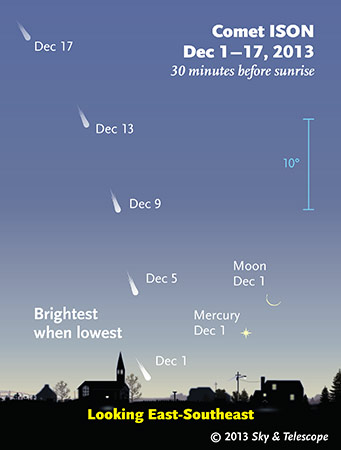
After waiting for about a year, Comet ISON (C/2012 S1) has finally reached the inner solar system. As I am writing this two days before Thanksgiving Day, the comet is hidden in the glare of the sun. Over the next few days it should climb back into the morning sky. Will it be visible, how bright will it be, and by what is the best means for locating it?
I and a couple other friends tried independently to observe ISON last weekend and this past Monday. We each scanned the horizon during morning twilight for the fuzzy interloper without any luck. The comet was washed out by the bright morning twilight.
On Thanksgiving Day, the comet will graze the sun, rounding it in a near miss by a distance smaller than the solar diameter. I plan to attempt viewing it in broad daylight using a dense dark #14 welding glass held at arm?s length to block out the sun?s intense glare while looking for ISON in its vicinity with the unaided eye for any indication that ISON will be during daytime. I may not succeed, but this is an opportunity I don?t want to miss. Of course, great care must be taken because of the comet?s angular proximity to the dangerously bright sun.
During early December, the comet will return to the morning sky climbing higher each day. If the tail is still visible it will be sticking above the horizon away from the sun as the comet appears to be moving backwards tail-war first. This is because the pressure of the solar wind always pushes the particles making up the tail away from the sun.
In morning twilight the comet may be hard to detect and a good chart will save a lot of aggravation. The best place to find an easy-to-use chart is at SkyandTelescope.com.
If bright, the comet might be visible in the morning sky as early as November 30 or December 1. Start looking at around 6:30 a.m. by scanning the horizon with binoculars. The comet will be very low so a clear unobstructed horizon and crystal clear sky is a must.
Even if the comet is bright it may be difficult to pick up with the unaided eye. So use binoculars to spot it. Best to use low power wide field binoculars ? 7x35, 7x50, 10x50, or even 10x70 for example. The higher the power the smaller the area of the sky you can see with them. You don?t want to use binoculars that pinch the field as though you?re looking through a pair of straws. You will want binoculars that give you a good crisp focus without blurriness.
Once you have ISON in the binocular, then try and see if you can see it with the unaided eye.
If you have a tripod and a camera capable of taking long exposures, give that a try. Use a number of different shutter speeds ? 1, 2, 4, 8, 16 seconds. Vary the aperture and film speed settings and experiment. When you review your images you may be surprised to find a gem among them showing the comet at its best.
If Comet ISON is like Comet 2011 L4 (PANSTARRS) last spring, it will be very photogenic. The photos will look better than the naked eye view of the comet.
Every four days or so ISON will be another 10 degrees higher in the morning sky at the same time. This means that after a week or two it can be viewed earlier in the morning in a darkened sky. However, as ISON moves away from the sun it will also probably rapidly fade.
If observing the evening sky is more appealing to you, then come to downtown Westminster on Friday night, December 6. Take a swing by Locust Lane or the Carroll County Library between 5:00 and 10:00 p.m. and you may see members from the Westminster Astronomical Society and their telescopes looking up at the moon or perhaps a Wintery star cluster. The event is ?Starlight Shopping? and is being hosted by the City of Westminster Recreation and Parks Department.
